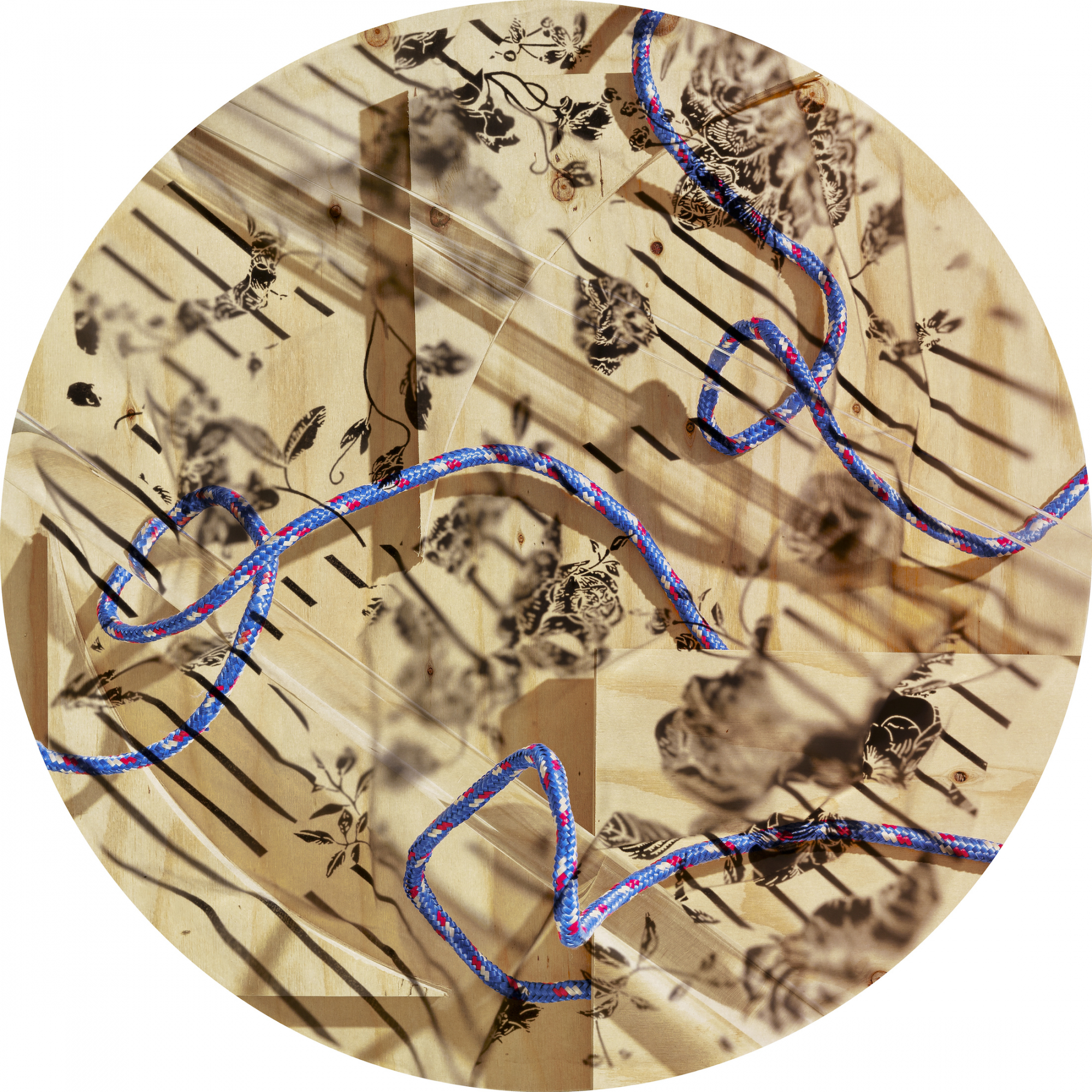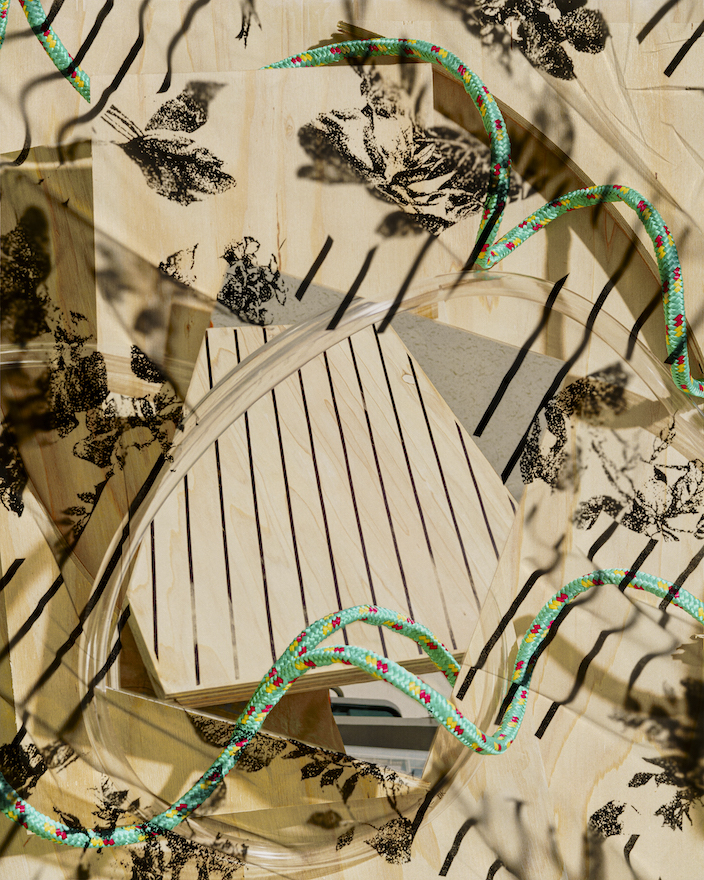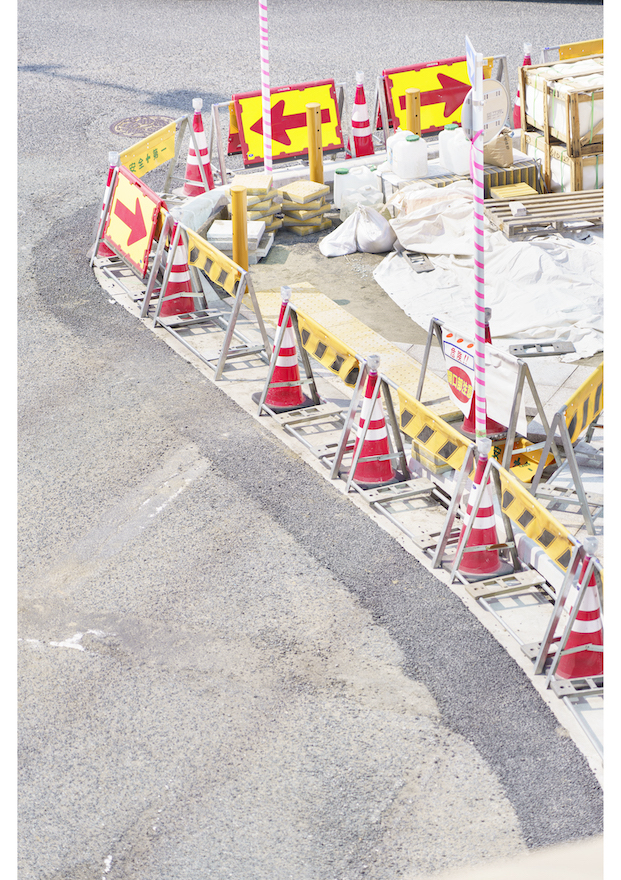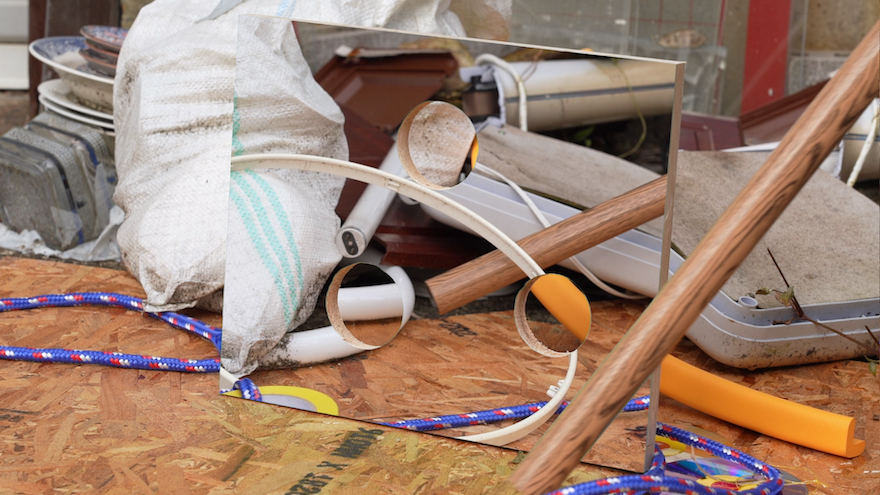Cultural Currency 12: Kano Shunsuke "In the sight of the forest, adrift in trees"@ Chiso Gallery
Collage, unbound and abyssal
By Shimizu Minoru
2023.05.17

Inkjet print, lumber, 600x600mm
In the late 1980s and 90s, after the decline of postmodern art, a tendency emerged in which, rather than “returning” to or “appropriating” the modernism of the early 20th century, artists discovered within modernism, albeit a modernism reinterpreted as a global and ununiform movement not limited to Europe, lineages that had been passed on in a misunderstood form, elements that had been overlooked and seeds of possibilities that had not germinated, and developed these into current expression. In the 21st century, this tendency, exemplified by such artists as Richard Tuttle and Okazaki Kenjiro, merged with the current called among other things “plural modernities” and “alternative modernism,” and today, together with “socially engaged art,” could be said to be dividing the art world. One of the lineages whose essence was never adequately understood and which has been handed down based on the misunderstanding that it represents “two-dimensional or three-dimensional composition that combines heterogenous elements” is collage, which was invented by Pablo Picasso and Georges Braque in 1912. For this reason it is natural that many artists irrespective of their country or region of origin or media are now using collage, yet most of these artists are simply repeating this misunderstanding.1
So, what is collage? According to Kano Shunsuke, it is “In the sight of the forest, adrift in trees.” The title of this exhibition is nothing other than a phrase that clearly describes the experience of viewing collage. The forest as a whole is visible, but trying to identify the individual trees is impossible. Because one cannot establish the “ground” required to identify them. In other words, collage is a process of continually rendering indeterminate and leaving suspended in midair this bottommost ground, the surface that forms the basis, that ought to support our perception.
Collages are, to put it plainly, collages of “layers.” Layers are the invisible, nonmaterial planes that form the basis of all visible images (including illusions), and began to be introduced surreptitiously by many artists in the form of optical projection planes created by concave lenses from as long ago as c. 1500 (according to David Hockney’s Secret Knowledge: Rediscovering the Lost Technique of the Old Masters). In the trompe-l’oeil art of the 17th century, there was an awareness even of the invisibility and nonmateriality of these planes (Cornelis Norbertus Gysbrechts’ The Reverse of a Framed Painting), and from the large mirror in Manet’s A Bar at the Folies-Bergère and the water surfaces in Monet’s “Water Lilies” series to postwar color field painting, Gerhard Richter’s photo-paintings and abstract works and as a basic concept behind Adobe Photoshop and other digital image processing software, it is a system that has continued to dominate our visual sense down through the ages.
To “show” layers, one simply needs to make the viewer aware of the fact that a certain image lies on a plane. Monet included water lilies floating on the surfaces of ponds, Richter used blurriness and halation, and spilled paint onto canvases and scraped it off with a squeegee. Photographers achieve this effect more simply by using a shallow depth of field. With a single action, a plane that was invisible (the surface of water, the surface of a mirror, the plane of focus) is made to stand out. However, this is not collage. When one layer stands out, we naturally distinguish between the first plane (A) and the image on top of it (B). Collage involves repeatedly betraying and overturning this hierarchical order (from bottom to top, A, B). The artist compresses (AB) into a single layer by adding C, then superposes onto this D, which cuts through the strata of layers and compresses D and the initial A, then superposes onto this E, etc. so that ultimately it becomes difficult to distinguish not only the hierarchical order of the layers, but the individual layers themselves. To make layers appear, it is necessary to collage something that suggests a basal plane, but at the same time collage is a process of betraying the hierarchy of the layers by repeatedly updating that basal plane. To put it another way, if the basal or bottommost plane is identifiable, it is not a collage.
 The methods Kano employs to suggest planes are truly diverse. Examples from this exhibition include woodgrain patterns (→ Braque’s faux bois), frame-like forms, shadows (→ Braque’s nails), (bicycle cords and stripes that look like) curved lines that cut through layers, floral patterns and stripes (→ wallpaper) and focus and lack of focus. The collages made using these methods appropriately (Pink Shadow) demonstrate such a stunning refinement one could even call them Manneristic.
The methods Kano employs to suggest planes are truly diverse. Examples from this exhibition include woodgrain patterns (→ Braque’s faux bois), frame-like forms, shadows (→ Braque’s nails), (bicycle cords and stripes that look like) curved lines that cut through layers, floral patterns and stripes (→ wallpaper) and focus and lack of focus. The collages made using these methods appropriately (Pink Shadow) demonstrate such a stunning refinement one could even call them Manneristic.
 In this way, Kano Shunsuke pays fresh homage to the collages of the early 20th century, but there is just one method from this period that he does not employ, and that is letters. As is widely known, in the collages of Picasso and Braque, stenciled letters and newspaper clippings appear as a method of suggesting planes. Naturally, letters and articles can be read, which has the effect of bringing meaning and context from outside the work into the work. And there is no doubt that to some degree letters are chosen and incorporated as symbols of the “real world.” That Kano does not use them indicates that his collages are formally closed and that he does not “choose and intentionally” incorporate meanings and contexts from outside the works. Probably this is not because he adopts the position that such matters are no concern of his as an artist, but because he is serious about collage being groundless. As noted above, collage is a process of continually overturning basal planes. Reading this in formal terms, it means not creating an initial plane, a plane that forms the ground. Rereading it in political terms, it means criticizing thinking itself that is based on the return to some basis, such as “the thing in itself (Ding an sich)” or “the world as it is.”
In this way, Kano Shunsuke pays fresh homage to the collages of the early 20th century, but there is just one method from this period that he does not employ, and that is letters. As is widely known, in the collages of Picasso and Braque, stenciled letters and newspaper clippings appear as a method of suggesting planes. Naturally, letters and articles can be read, which has the effect of bringing meaning and context from outside the work into the work. And there is no doubt that to some degree letters are chosen and incorporated as symbols of the “real world.” That Kano does not use them indicates that his collages are formally closed and that he does not “choose and intentionally” incorporate meanings and contexts from outside the works. Probably this is not because he adopts the position that such matters are no concern of his as an artist, but because he is serious about collage being groundless. As noted above, collage is a process of continually overturning basal planes. Reading this in formal terms, it means not creating an initial plane, a plane that forms the ground. Rereading it in political terms, it means criticizing thinking itself that is based on the return to some basis, such as “the thing in itself (Ding an sich)” or “the world as it is.”


 Compared to Pink Shadow, which displays stunning Mannerism, the straight photography (spacious notion) achieves the same thing directly, which is to say it simply captures the world in front of our eyes with no image manipulation whatsoever. The video work (the contact slips) appears at first sight to be a complex collage video made using a mirror with a hole in it, but in fact it consists of nothing more than the same process shot from two different angles superposed with chroma keying (the blue board with a hole in it itself also appearing on screen). These appear to punch holes in Kano’s Mannerism. While it may be true that the essence of collage is deconstructive, it is not uninvolved in the real world, nor should it have to be involved. It seems that Kano’s collages are in the process of shifting to the next stage.
Compared to Pink Shadow, which displays stunning Mannerism, the straight photography (spacious notion) achieves the same thing directly, which is to say it simply captures the world in front of our eyes with no image manipulation whatsoever. The video work (the contact slips) appears at first sight to be a complex collage video made using a mirror with a hole in it, but in fact it consists of nothing more than the same process shot from two different angles superposed with chroma keying (the blue board with a hole in it itself also appearing on screen). These appear to punch holes in Kano’s Mannerism. While it may be true that the essence of collage is deconstructive, it is not uninvolved in the real world, nor should it have to be involved. It seems that Kano’s collages are in the process of shifting to the next stage.
 ——————————–
——————————–
1. Incidentally, the essence of Ohtake Shinro’s art, which is noticeably being reassessed, is not collage but accumulation. Though viewers may see in it the collaging of layers, this is nothing more than the application of this way of looking by the viewer. ——————————–
Shimizu Minoru
Critic. Professor, Doshisha University.
Kano Shunsuke “In the sight of the forest, adrift in trees” is being held at Chiso Gallery through June 12, 2023.

Pink_Shadow_93, 2023

Pink_Shadow_97, 2023

specious notion_46, 2023

specious notion_47, 2023

the_contact_slips, 2022

Installation view
1. Incidentally, the essence of Ohtake Shinro’s art, which is noticeably being reassessed, is not collage but accumulation. Though viewers may see in it the collaging of layers, this is nothing more than the application of this way of looking by the viewer. ——————————–
Shimizu Minoru
Critic. Professor, Doshisha University.
Kano Shunsuke “In the sight of the forest, adrift in trees” is being held at Chiso Gallery through June 12, 2023.